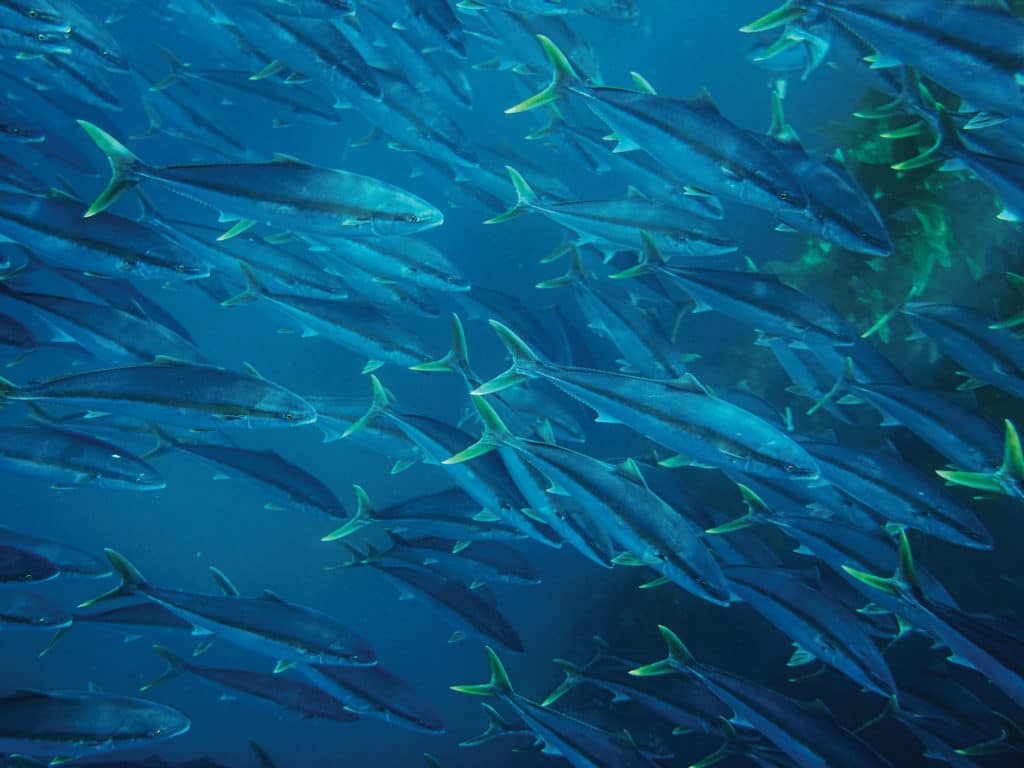
Santa Barbara Island isn’t much of an island. Anglers call it “the Rock.” Yet the waters run deep around this smallest of the Channel Islands, and that’s exactly where we headed one morning aboard my 21 ½-footer, Split Decision, tanked up with live squid in pursuit of big California yellowtail.
As my two sons, Brandon and Josh, and I reached the east side of the mist-shrouded island, we saw what we were after on the fish finder: the distinctive sonar marks of yellowtails near the ocean floor 150 feet below. With the current running to the north, we set the anchor a few hundred yards off the island, pinned live squid to our hooks, and sent them to the bottom with 10-ounce sinkers.
Almost immediately, Josh hooked up, then Brandon and then me. A California yellowtail is virtually unstoppable on its first run. Three lines hissing around the boat complicated things, as did the island’s hungry sea lions intent on stealing our fish. But somehow we landed all three fish one by one, the biggest weighing 28 pounds. And our day had just started. We would eventually deck nine husky yellowtails before noon, truly a memorable trip at the Rock.
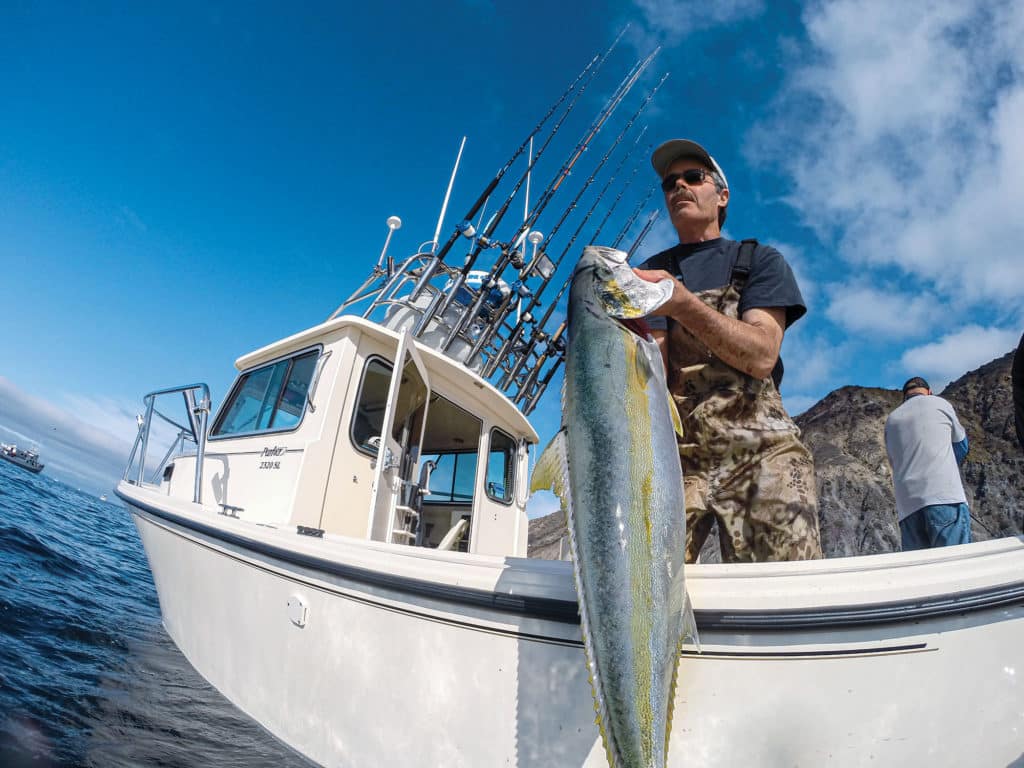
Coveted Catch
One of Southern California’s most prized game species, yellowtail can reach weights in excess of 40 pounds. Fish approaching this size are known admiringly as mossbacks. The state hook-and-line record is 63.1 pounds, caught at Santa Barbara Island on June 18, 2000. But any yellow over 20 pounds is a prize, and those in the 25-to-30-pound range earn you bragging rights. These fish possess formidable strength and have a frustrating tendency to peel off toward rocks, heavy kelp and other snag-infested structure once hooked. While anglers employ a wide range of techniques for yellowtail in a variety of situations and habitats, targeting them in deep water is one of the most consistent strategies for catching big fish. Let’s look at some proven methods.
Squid Sense
Dense schools of opalescent squid spawn off the Southern California coast and offshore islands when the water gets cooler during late fall, winter and spring. That rings the dinner bell for yellows. Areas where the squid spawn—known as the squid grounds—are usually in depths of about 120 to 150 feet over sandy ocean floor.
Squid show up as light-blue marks on a fish finder, while the nests of egg pods mark as a blue fuzz on the seabed. Schools of yellowtails show as sharply angled red marks on sonar.
Bites often come in flurries, so it’s important to have baits in the strike zone at all times. Yellows also tend to feed when a mild to strong current is running, so anchoring your boat is one of the best ways to fish the squid grounds.
The idea is to keep a live squid about 10 to 20 feet above the bottom. Yellowtails tend to focus their eyes upward while hunting, so fishing too close to the seabed can result in bites from junk fish, such as bat rays, leopard sharks and guitarfish. Some of the best terminal rigs for fishing live squid include dropper loops, sliding-egg sinker rigs or heavy leadheads.
Lures that mimic opalescent squid can also prove effective, like the Savage Gear 3D Swim Squid in the 5-inch length, which comes pre-rigged with a hook and a 1-ounce internal weight. The best colors are Glow and Green Eye. Another squid lure is Chasebaits’ Ultimate Squid in the 7.8-inch version in the Market Squid color. This lure needs to be rigged with a leadhead.
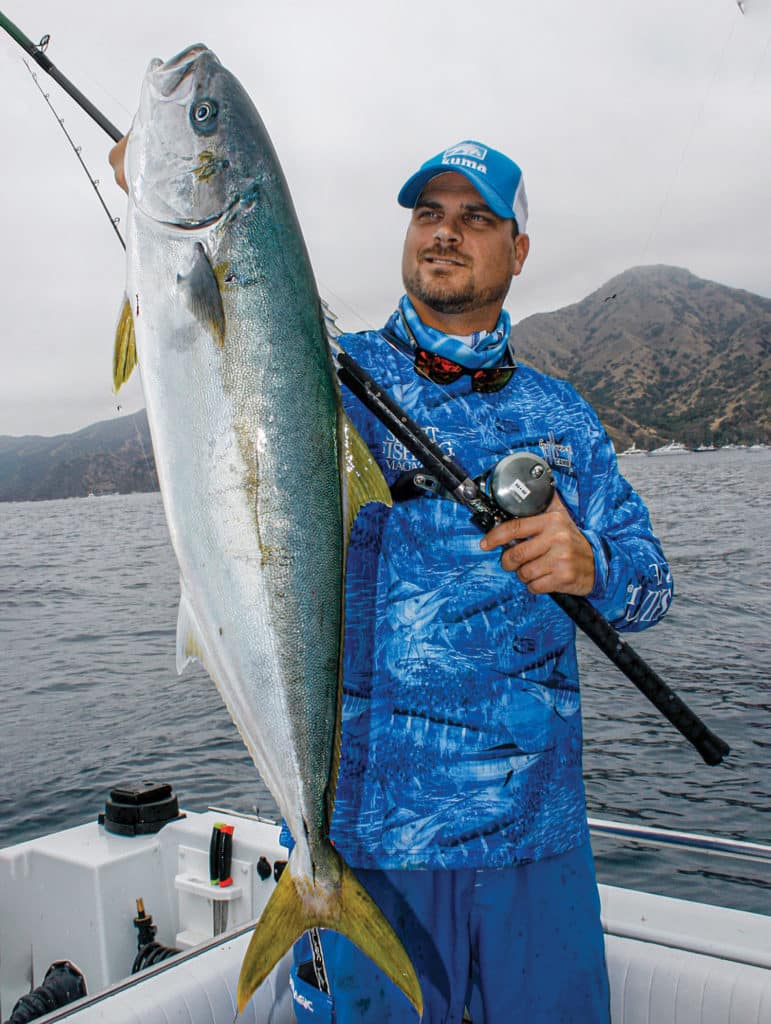
Mackerel Magic
When the ocean waters warm off the Southern California coast in summer, live Pacific mackerel (aka greenies) become one of the hottest baits for yellowtails, including deep-dwelling mossbacks.
A case in point: On a summer day on the Farnsworth Bank on the southwestern side of Santa Catalina Island, I spied deep sonar marks of yellowtail schools roaming amid the rocky pinnacles of this legendary high spot.
But these fish ignored our offerings of live sardines and heavy metal jigs. Once we dropped a live mackerel, however, it was different story. As soon as a 6- to 8-inch-long greenie neared the bottom, a big yellowtail would race to eat it. We used every mackerel in the livewell that day, and lost a few mossbacks to the jagged pinnacles and bull kelp, but managed to boat seven yellows, all over 20 pounds, in the span of three hours.
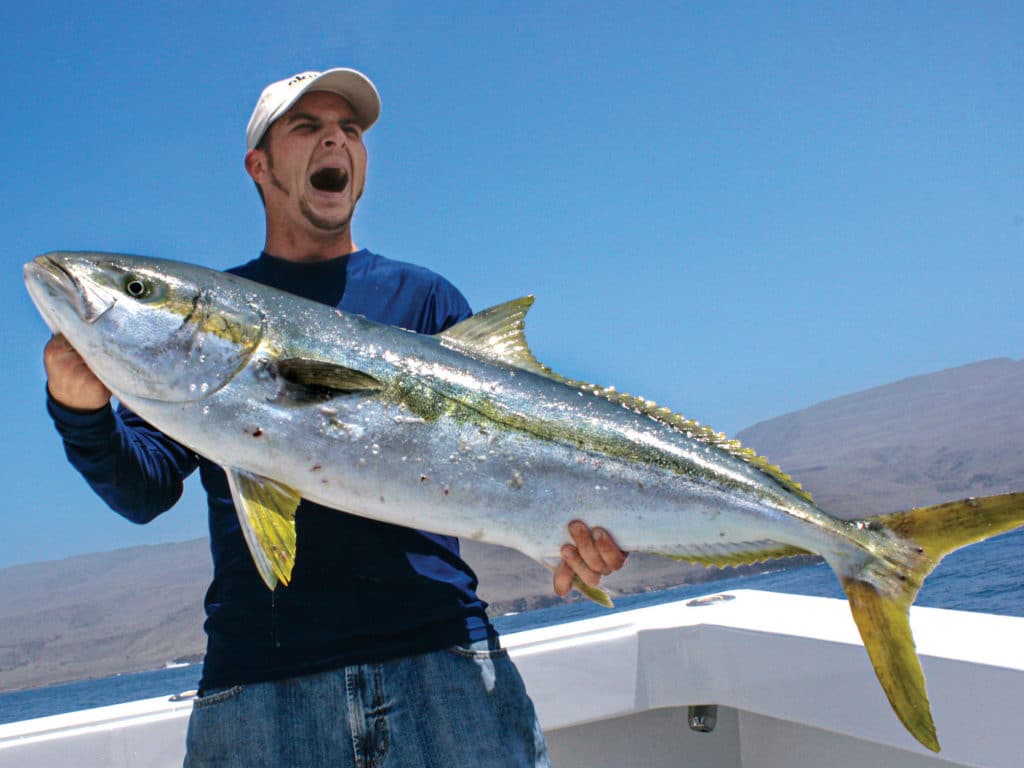
Deep-Troll Tactics
Live mackerel can be fished in a variety of methods for yellowtails, but one that targets big yellows specifically is slow-trolling the baits deep. This method works well when the breeze opposes the current, a condition that makes it difficult to fish effectively while anchored.
I like to use a 10- to 12-ounce torpedo sinker ahead of a 5-foot fluorocarbon leader with a 3/0 to 4/0 Owner Gorilla Light hook. The weight keeps the live mackerel at a productive depth.
Bridling the hook through the nose of the mackerel helps prevent it from turning into the bait and usually results in an instant hookup, even when slow-trolling with the reel in gear.
Once we mark deep-dwelling yellows on the fish finder, the crew deploys two lines, one at each corner of the transom, and we try to troll as slowly as possible by keeping the engine at dead-idle while in gear. If the breeze is blowing fairly strong, you can also drift with the wind, and then slow-troll back upwind to restart a drift.
Yo-Yo Yellows
There are times in late fall and early winter when big yellowtails charge up from the depths to feed at the surface, often chasing schools of sardines and other forage fish.
You can present surface lures to these yellows, but the best bet is often fishing deep with a heavy metal jig using a technique called yo-yoing—so named because you drop the jig straight down and reel it back up. When fishing this way, we look for surface action, including diving birds, showers of bait and boiling yellowtails. We race to the scene and drop heavy metal jigs to depths of 100 feet or more, then put the reel in gear and wind furiously. Do it right and you’ll get bit within the first four to five turns of the reel handle.
Great yo-yo jigs include the Salas 6X Jr. and Tady AA Heavy in blue and white, chrome, and green, yellow and white.
Though it seems counterintuitive, yo-yoing works. Don’t worry about imparting any action or the lure spinning on the way up. Yellows are like house cats—they home in on fast-moving objects and can’t resist pouncing. Retrieve the lure too slowly and these fish will ignore it. California yellowtail feed in a wide range of ocean habitats, from rocky shores to offshore kelp paddies. But if you’re intent on catching big yellows, think deep.
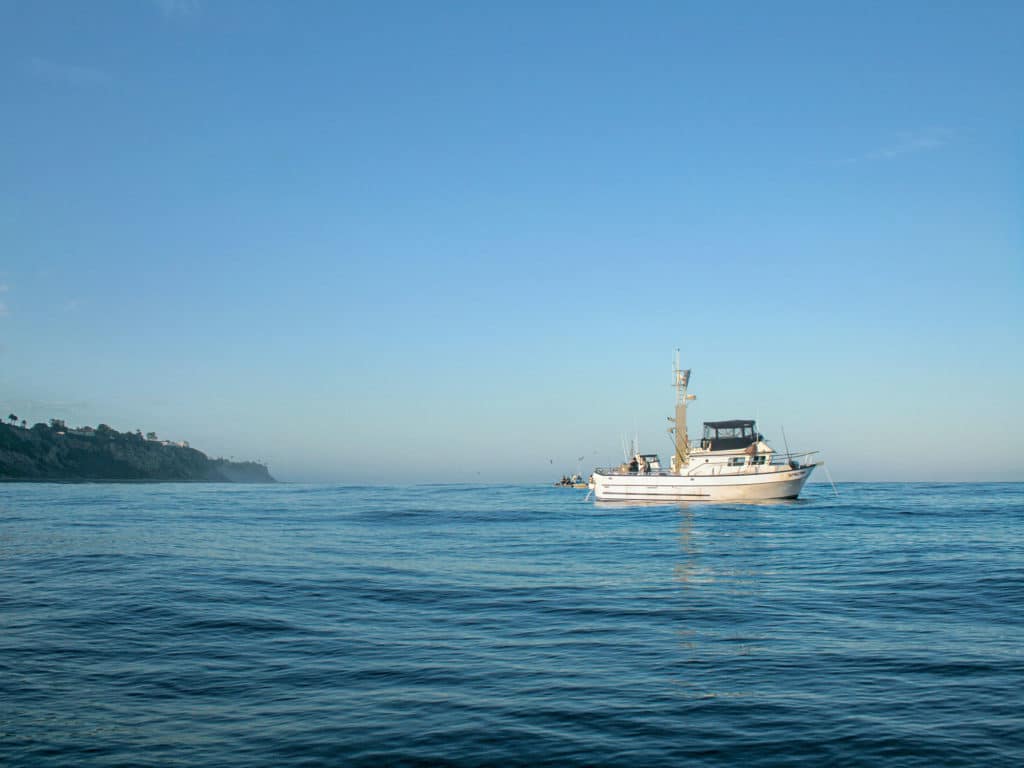
Current Affair
Astute California anglers are always looking for moving water when yellowtail fishing. Yellows rarely bite when there is no current, but will often go on feeding sprees once the water starts moving.
Sometimes it’s a waiting game. I remember one day when we arrived too late and missed the morning bite on the back side of Santa Catalina Island. We set the anchor and waited five hours for water movement. When that occurred, the yellows moved in and bit wide open for an hour. Once the current slacked off, the bite ended.
SWS Planner
- What: Yellowtail from 20 to 40 pounds
- Where: Along flats and rocky bottom areas in anywhere from 120 to 150 feet of water
- When: Year-round
- Who: Boating anglers with reliable craft from 20 feet and up. Don’t have a boat? Here are three private-charter choices:
- Options Fishing, 562-980-2009, optionsfishing.com
- Bight Sportfishing, 949-212-0719, bightsportfishing.com
- Dreamer Sportfishing, 562-394-8602, longbeachsportfishing.com
Power Play
You need stout tackle to land big yellowtails. Use a 7-foot rod rated for 30- to 50-pound-test line and matched with a lever-drag reel, such as an Okuma Makaira 10II or a Shimano Talica 10II. Spool the reel with 65-pound-test braid with 30- to 40-pound-test fluorocarbon top shot.









